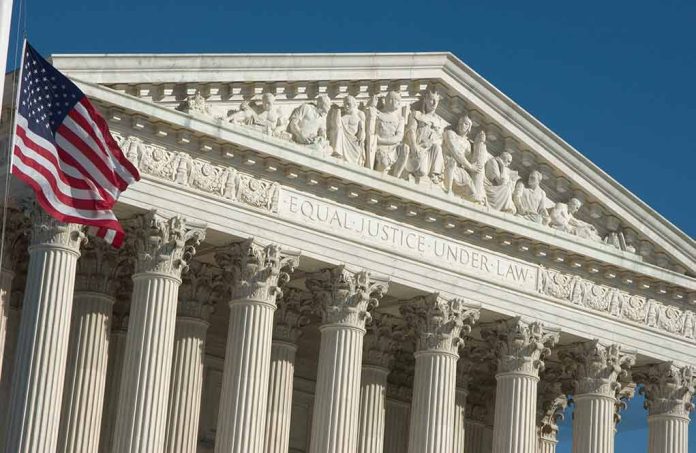
The U.S. Supreme Court has refused to hear challenges to California’s ban on gun shows on state property, potentially setting a concerning precedent for Second Amendment rights across America.
Key Takeaways
- The Supreme Court declined to review B&L Productions v. Gavin Newsom, effectively upholding California’s ban on gun shows on state property.
- The decision follows the 9th U.S. Circuit Court of Appeals’ previous ruling that upheld the California law.
- Gun rights advocates view this as contradictory to Justice Clarence Thomas’s 2022 stance on constitutional protections for bearing arms.
- Critics point to Chief Justice John Roberts and Justice Amy Coney Barrett as failing to uphold Second Amendment protections.
- The decision raises broader questions about the judiciary’s interpretation of the Bill of Rights as a limit on government power.
Supreme Court Declines Review of California Gun Show Ban
In a move that has alarmed Second Amendment advocates nationwide, the U.S. Supreme Court has opted not to hear challenges to California’s prohibition of gun shows on state property. The case, B&L Productions v. Gavin Newsom, had previously been upheld by the 9th U.S. Circuit Court of Appeals, which has a reputation among conservatives for liberal-leaning decisions. By declining to review the lower court’s decision, the Supreme Court has effectively allowed California’s restrictions to stand without constitutional scrutiny at the highest judicial level.
Oh shocker. No Snope or Ocean State on the SCOTUS Orders LIst (again). But the B&L Productions case from California was denied. So,we play on. pic.twitter.com/qdvKKDtpVb
— WashingtonGunLaw (@GunWashington) April 28, 2025
The California Rifle & Pistol Association and other gun rights organizations had hoped the Supreme Court would address what they view as a clear infringement on constitutional rights. The ban prevents lawful gun shows from taking place on state-owned fairgrounds, despite these events having traditionally served as places for law-abiding citizens to legally purchase firearms and related equipment after completing required background checks and waiting periods.
Conservative Disappointment in the Court’s Direction
This decision has reignited criticisms of the federal judiciary’s approach to Second Amendment rights. Gun rights supporters had gained hope following the Court’s 2022 New York State Rifle & Pistol Association v. Bruen decision, in which Justice Clarence Thomas emphasized that the Constitution protects an individual’s right to carry a handgun for self-defense outside the home. However, the Court’s refusal to hear the California gun show case appears to contradict that landmark ruling’s spirit.
“For months, high-ranking Government officials placed unrelenting pressure on Facebook to suppress Americans’ free speech. Because the Court unjustifiably refuses to address this serious threat to the First Amendment, I respectfully dissent,” expressed Justice Alito. While Justice Alito’s quoted dissent relates to a different case involving free speech, it reflects a growing concern among constitutional originalists about the Court’s willingness to defer to government restrictions on explicitly protected rights. Critics have specifically pointed to Chief Justice John Roberts and Justice Amy Coney Barrett, suggesting they have not lived up to expectations in defending constitutional freedoms.
Constitutional Principles at Stake
The controversy surrounding this decision extends beyond gun rights to fundamental questions about the nature of the Bill of Rights itself. Second Amendment advocates emphasize that the constitutional language is unambiguous: the right to keep and bear arms “shall not be infringed.” They argue that the Bill of Rights was designed specifically as a limitation on government power, not as a grant of rights from government to citizens. By allowing California’s ban to stand without review, critics contend the Court has failed in its duty to enforce these constitutional boundaries.
Gun rights supporters also point out that restrictions like California’s primarily affect law-abiding citizens rather than criminals. They argue that prohibiting legitimate gun shows does nothing to address gun violence, as those with malicious intent are unlikely to be deterred by such regulations. Instead, they suggest that armed, responsible citizens provide the most effective protection against those who would violate the law, citing numerous instances where legally armed individuals have prevented mass casualties.
Broader Implications for Constitutional Rights
The Court’s decision not to hear this case may have implications beyond California. By allowing a state to prohibit legal gun commerce on public property without facing the highest level of judicial scrutiny, the Supreme Court has potentially opened the door for other states to implement similar restrictions. Second Amendment advocates worry this represents a troubling pattern of the judiciary deferring to government restrictions rather than holding governments to the strict standard that should apply when constitutional rights are at stake.
For many gun owners across America, this decision reinforces concerns about the future of Second Amendment protections. While the Court’s composition remains predominantly conservative on paper, decisions like this one raise questions about whether some justices are truly committed to an originalist interpretation of constitutional rights or are instead adopting a more deferential posture toward government restrictions that would have troubled the nation’s founders.
Sources:
SCOTUS Betrays Again – This Time Sides with California Against Gun Owners
Supreme Court won’t hear challenge to California ban on gun shows on public land



